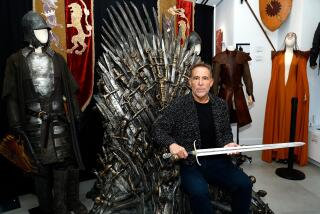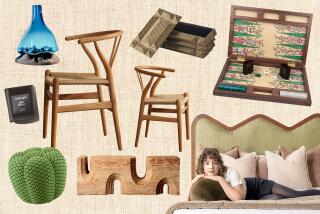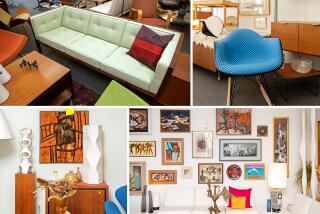A cooling-off
- Share via
ON A DAY when the Dow lost 508 points and consumer confidence plummeted with the stock market, one might consider the sale of $2.13 million in home furnishings to be a respectable haul. But Richard Wright, director of the Chicago auction house Wright, couldn’t help but wonder whether his Modern Design event on Tuesday signaled the beginning of the end for a seven-year run of record prices on 20th century furniture and other design collectibles.
Gross sales were down from the previous year’s $3 million, and perhaps more important, the number of bidders dropped 50%. “And there were no fireworks,” Wright said. “As the auction progressed, you could see the results go down.”
The day began well, with more than three dozen early Charles and Ray Eames designs bringing in more than $300,000. But by the end of the event, about 40% of the 417 items for sale had been “passed,” Wright said, using auction parlance for lots that failed to meet the minimum price set by the seller. Historically, he said, the number of passed lots in design auctions runs 15% to 25%.
Just as with stocks, prices for blue-chip pieces of design have risen for years. Works by individuals such as George Nakashima and Paul Evans have seen prices jump from five figures to six.
“We are linked to the broader economy, and when there is a lot of money, people are less concerned about paying a premium for a special piece and prices rise,” he said. So, too, do sellers’ dreams of profits.
“If you have a chair that has sold for $40,000, it’s hard to put it up for auction at $10,000 to $15,000,” Wright said, adding that sellers’ high expectations led to the increased number of passed lots this week. A Piero Fornasetti mirror shaped like the sun sold for more than $30,000 in 1998 but could not get one-third of that price on Tuesday. It ultimately went unsold.
Just last year, the Beverly Hills auction house I.M. Chait saw Leonardo DiCaprio and Nicolas Cage get into a bidding war for a Tyrannosaurus bataar skull at its natural history sale. Cage won, paying $276,000. Last month a slightly smaller skull of the same species, an Asian relative of T. rex, sold for $96,000, well below I.M. Chait’s $140,000 to $180,000 estimate.
On Wednesday, Doyle New York’s auction fared better. Of 91 items on the block, 69 sold, for a passed-lots rate of 24%. The highlight was an Art Deco vase by French designer Jean Dunand that sold for $80,500.
“Perhaps people are going to move away from really edgy things in difficult times,” senior vice president David A. Gallager said, noting that bidding on a set of four avant-garde bar stools by artist Aaron Lown never reached Doyle’s $6,000 estimate, although a single stool had previously sold for $2,000.
Wright agreed that more experimental designs will probably be a harder sell in bad economic times. A rare fiberglass Floris chair, one of about only 50 produced between 1968 and 1974, failed to reach an opening bid of $20,000 in Wright’s Tuesday auction.
If investors are yanking money out of stocks and real estate, they do not appear to be pouring it into design collectibles. Even if sellers lower their sights and prices fall, Wright isn’t convinced that design will be the new financial portfolio. “I’m always hesitant to treat these objects as investments, which implicitly suggests they will rise in value,” he said. “Unlike, say, cars or clothes, quality design pieces are assets that can appreciate, but it is part of those markets that have cycles, just like dot-coms and real estate.”
More to Read
Sign up for The Wild
We’ll help you find the best places to hike, bike and run, as well as the perfect silent spots for meditation and yoga.
You may occasionally receive promotional content from the Los Angeles Times.










